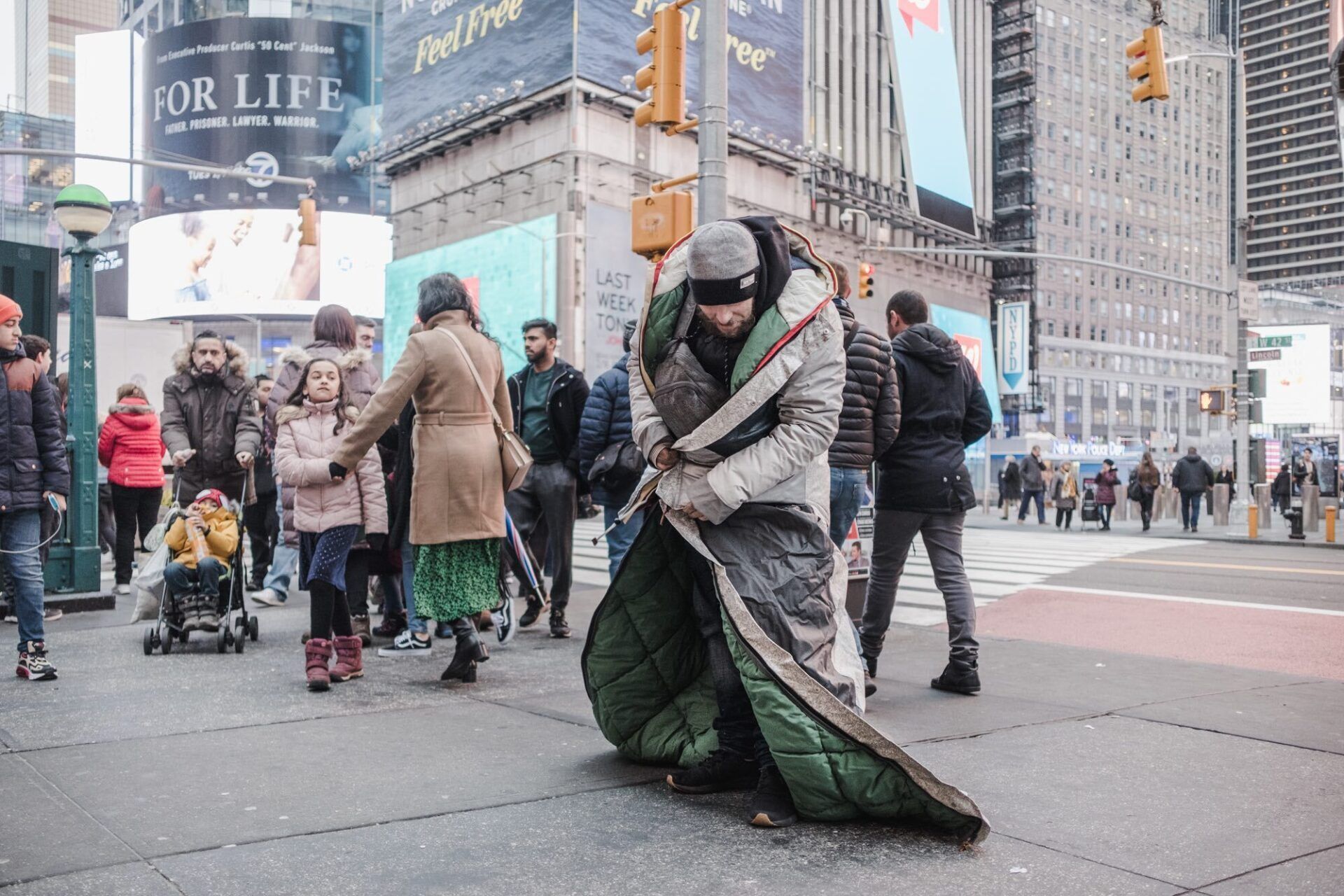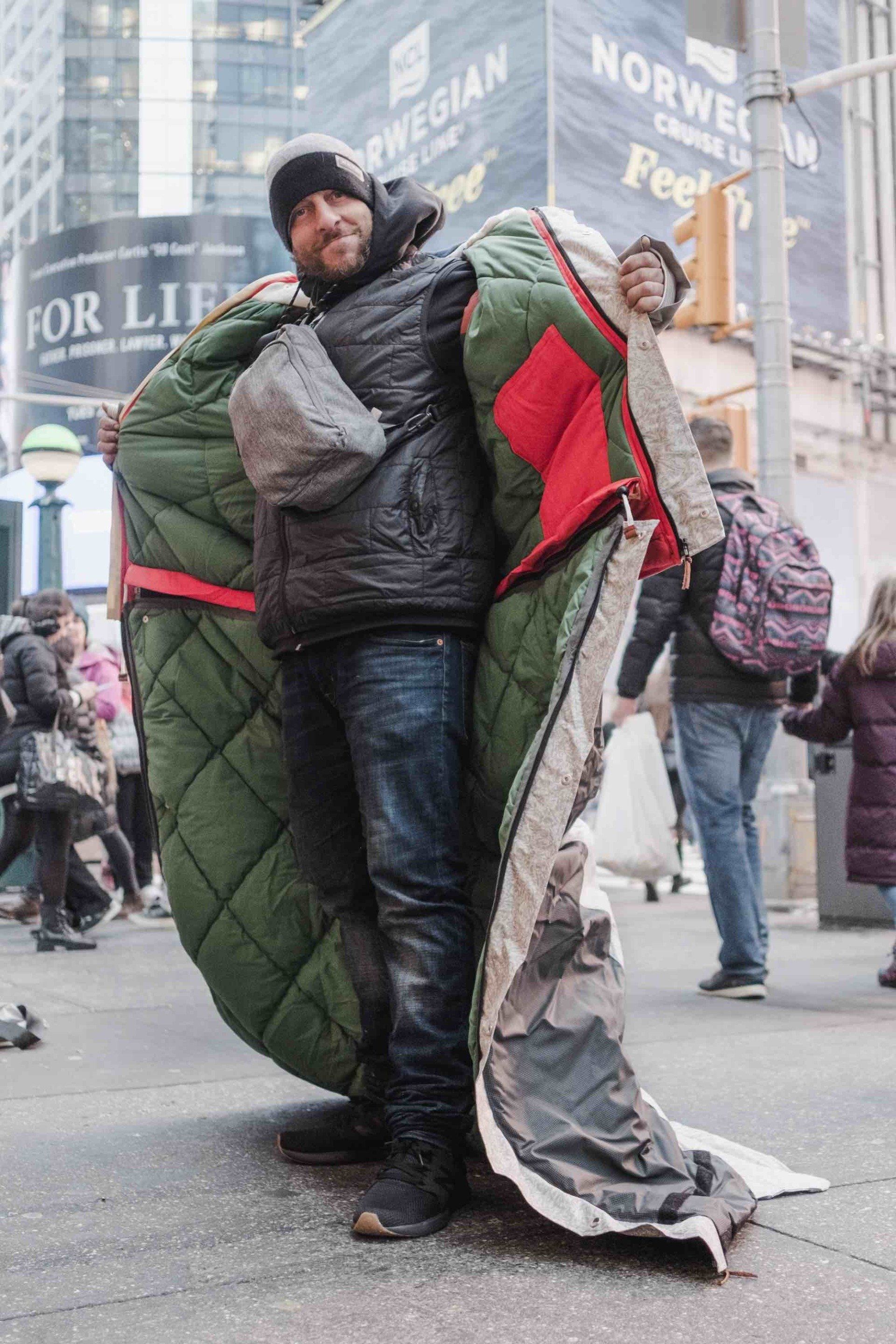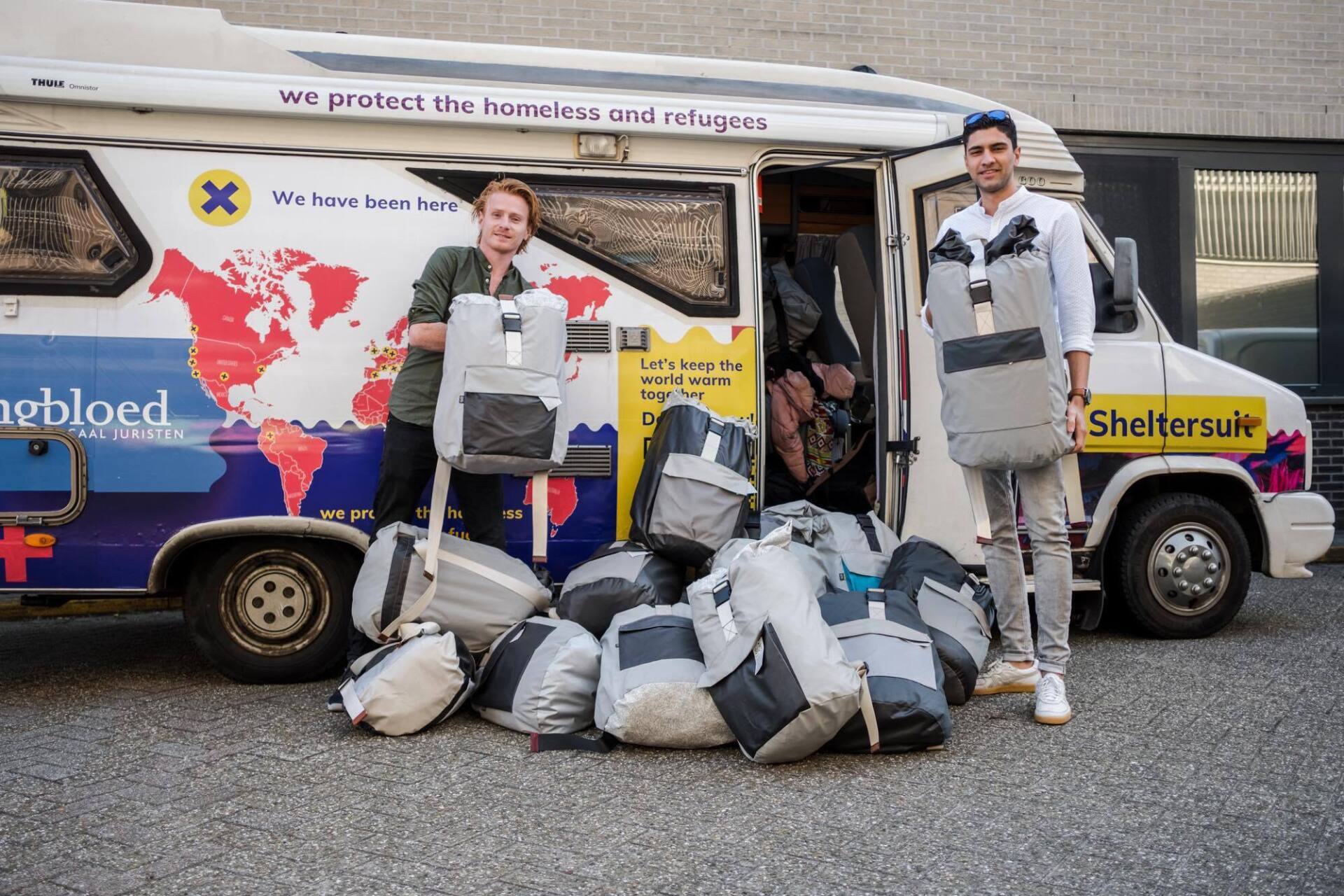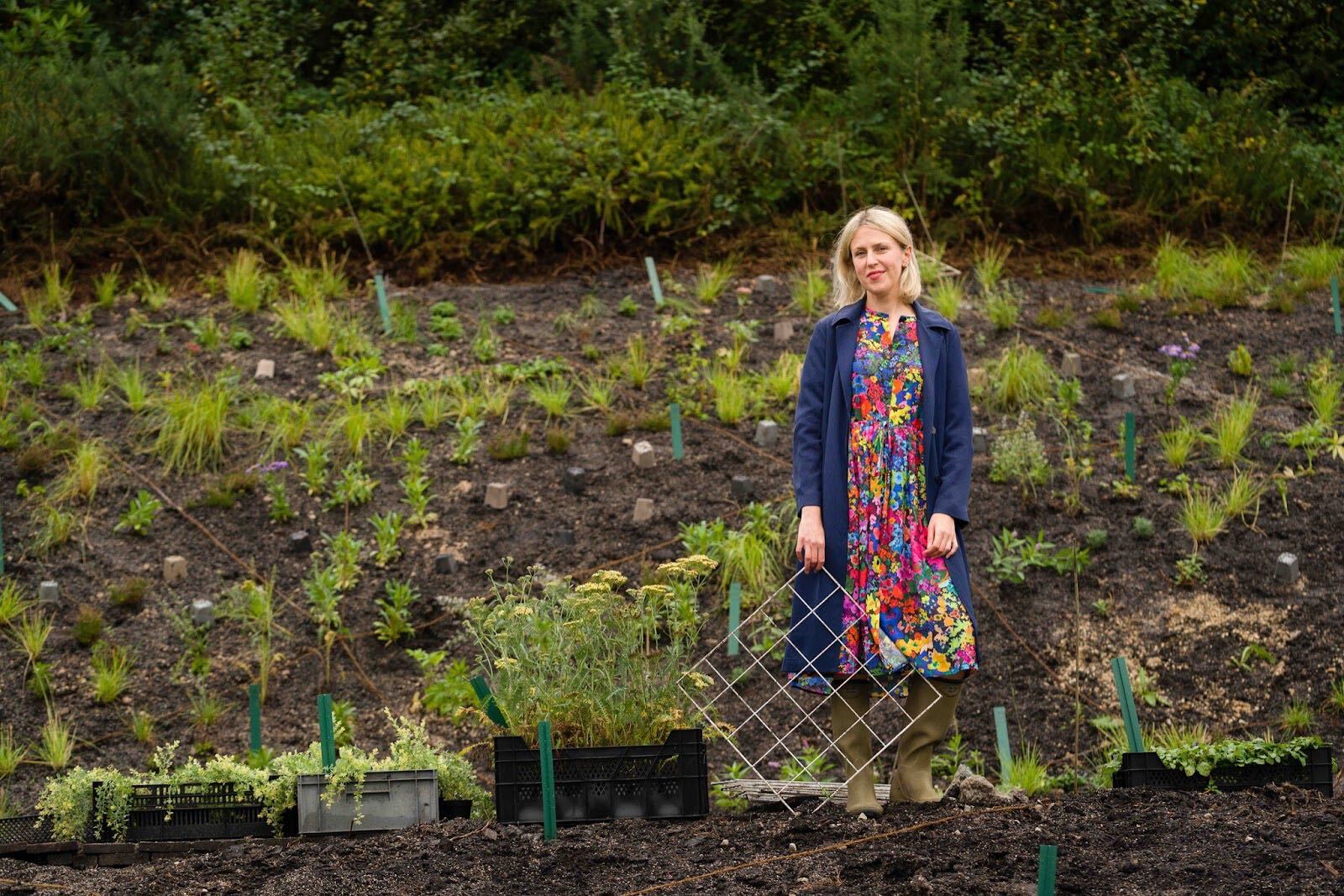Fashion/Business- 1 April 2022 - by C. Mauer
Sheltersuit
- charity, real fashion circularity, life stories
and a also new fashion initiative
Exclusive interview - 1 April 2022
Find out more under sheltersuit.com

Sheltersuit in NYC 2020
©Tony Docekal
Sheltersuit Foundation is a non-profit organization founded in 2014 by Bas Timmer to develop products that can alleviate the symptoms of homeless people. The Sheltersuit and the Shelterbag were created. Alethea & Art Magazine received an interview from the Sheltersuit team about the idea of the foundation, the business model and also about the new fashion line.
Sustainability and circularity of fashion are indispensable. Sheltersuit is a well-rounded circularity, as the jackets/sleeping bags are tailored from sent used sleeping bags and other fabric leftovers. Each Sheltersuit looks different, but is thought out to the last detail. It is important that the Sheltersuit protects its wearer from hypothermia and is water repellent, as this will lead to hypothermia in no time.
Bas Timmer was a fashion student in the Netherlands. When a friend's father passed away, he decided not to start another fashion line, but to offer his skills to the community. A lot has happened since its inception and the Sheltersuit has been used around the world, including during the 2017 refugee crisis in Lesbos.
Bas Timmer's idea would not be possible without supporters from the business community. The business model is based on donations from companies or private individuals, with whose support the homeless then receive their Sheltersuits.
A donation from the Designer Gabriela Hearst from Chloé resulted in 250 Sheltersuits being given to the homeless in New York. Recently, Sheltersuit also launched their own Fashion collection. This is primarily a campaign to raise awareness about homelessness, but also shows the outstanding design talent of Bas Timmer.

Sheltersuit Founder Bas Timmer
©Tony Docekal
Alethea & Art Magazine: To understand your business model – are the Sheltersuits given away to the homeless or bought by the municipalities?
Sheltersuit: The Sheltersuits are usually ‘sponsored’. Firms or wealthy individuals make large donations to the foundation at once for a certain amount of Sheltersuits. We match these donations with organisations – like Caritas – who make sure the Sheltersuits end up with people who need them the most.
What also happens is that an organization like Caritas has secured the funding of Sheltersuits from their own network/municipality and they place an order with us. So, we are like a ‘regular’ business, but the money that comes in to produce the Sheltersuits is all donations.
Alethea & Art Magazine: Do you also plan to be active in Germany?
Sheltersuit: We are activity in Germany, mostly through Caritas and Heilsarmee. However, we do not have a production space or office in Germany.
Alethea & Art Magazine: Who developed the suitable form of the Sheltersuit – was it with concerned people?
Sheltersuit: Bas Timmer is the one who designed the Sheltersuits from scratch. The first version was a thick sweater sewn onto a sleeping bag. Through feedback loops with actual users of the suits - the homeless - the Sheltersuit as we know it today came to be. An example of feedback was that the bottom of the suit needs to have Velcro on it instead of being closed off, in case a person sleeping in the suit needed to get up quickly in case of emergency.
Alethea & Art Magazine: If Sheltersuit is made of recycled materials, is every Sheltersuit different?
Sheltersuit: The model is always the same, but the colors are different, depending on the donated materials.

The donated sleeping bags have arrived in the factory in Netherlands / each Sheltersuit looks different
©Sheltersuit

Bas Timmer in conversation in UK
©Tony Docekal

Sheltersuit in detail - NY 2020
©Tony Docekal
Alethea & Art Magazine: Which brands do you cooperate with?
Sheltersuit:We have cooperated with many brands already. A good example is the cooperation we have with Auping (Dutch bedding company). Together with Auping, we designed the mats that go inside the Shelterbags (lightweight ‘summer’ version of the Sheltersuit). We continue this relationship for future product development.
Another example is our collaboration with fashion brand Chloé. Last year, Gabriella Hearst presented her first ready-to-wear collection at Paris Fashion Week, and Bas was asked to design a collection of bags and Sheltersuits made from materials from previous Chloé collections. Every time a bag was sold, two Sheltersuits were donated. Sheltersuit received a lot of (fashion) media attention from this collaboration, which resulted in increased awareness of Sheltersuit’s mission and donations.
Alethea & Art Magazine: You have also launched your own fashion brand – what are your goals with this line?
Sheltersuit:The collaboration with Chloé inspired Bas to go back to his fashion designer roots (he was once a fashion graduate). The goal of the fashion label is to increase the visibility of the Foundation through communication via the website, social media, and the clothing. This way, we create a greater awareness for the problem of homelessness with a new target audience.
Alethea & Art Magazine: What are your vision and goals with Sheltersuit?
Sheltersuit: Our vision is that every person who is forced to sleep on the streets is warm, dry, and comfortable. We believe in being there for people who cannot afford the products to protect themselves from the elements.
Alethea & Art Magazine: Thank you very much for the interview.
The interview was conducted by C. Mauer.

Netherlands 2020
©Sheltersuit

Lesbos 2017
©Sheltersuit

©Sheltersuit
Currently 150 million people are homeless and the economic impact of COVID-19 has made the number worse. Restrictions on public life, such as the federal government's AHA rules, have resulted in some homeless shelters being closed or unable to be fully staffed.
The Sheltersuit site also profiles the life stories of homeless people who live on the streets for very different reasons. Or initiatives such as the cooperation with the Berlin doctor's mobile of Caritas, with whose help Sheltersuits in Berlin, when at that time, in the winter of 2020, there were 850,000 homeless! in the whole Germany.
Homelessness is a long chain of circumstances and strokes of fate, or a way of life, quite freely chosen. In any case, they deserve the attention and respect, and it is hoped that Sheltersuit will find more business collaborators.
Fashion line Sheltersuit, which shows the high creativity of Bas Timmer.

Sheltersuit Label BTS Lookbook AW22
©Tony Docekal

Sheltersuit Label BTS Lookbook AW22
©Tony Docekal

Founder Bas Timmer - Sheltersuit SHOWROOM AW22
©Tony Docekal
Other initiatives of Sheltersuit
Donations and sleeping bag donations
Interested parties are also invited to donate or send in their sleeping bags, the ones made of synthetics, and not wool, because these cannot be purified.
Sleep Over
An idea to raise awareness about the reality of the homeless. Participants can sign up on the Sheltersuit website and then sleep outside for 1 night. They are encouraged to invite their friends and family to the sleepover and then raise money.
Learn more:
Alethea & Art Magazine recommends:

Art Calendar, 31 March 2022
Tentative Words Change Everything
sculptures by Turner Prize-shortlisted Nathan Coley light up Sussex.
The artist exclusively answers some questions about the project to Alethea & Art Magazine.
"You imagine what you wish for"
a slogan chosen by Nathan Coley for our time.
April 2 to August 29, 2022 - held in the County of Sussex

Art Calendar / Environment & Art, 27 March 2022
Pollinator Pathmaker - the largest living artwork ever created for climate change mitigation blooms in spring. Alethea & Art previously reported when Pollinator Pathmaker - a 55-foot-long living artwork by Alexandra Daisy Ginsberg was planted in the fall of 2021. The project is dedicated to the vital role of pollinators and will be in full bloom for the first time this May at the Eden Project in Cornwall. The bees, moths, beetles and wasps that this artwork is all about have also arrived in the meantime.
Alexandra Daisy Ginsberg as the plants were sown.
Image: Steve Tanner

Art Calendar, 20 March 2022
The non-profit association "Kunst hilft geben für Arme und Wohnungslose in Köln e. V." (Art helps give for the poor and homeless in Cologne) is organizing a benefit art exhibition with originals, editions, prints and sculptures by the Cologne action artist HA Schult on April 3, 2022 at Pan Kunstforum Niederrhein for the benefit of victims of wartime violence. 100% of the proceeds will be distributed to war refugees from Ukraine and homeless people.
The artist will be present.


